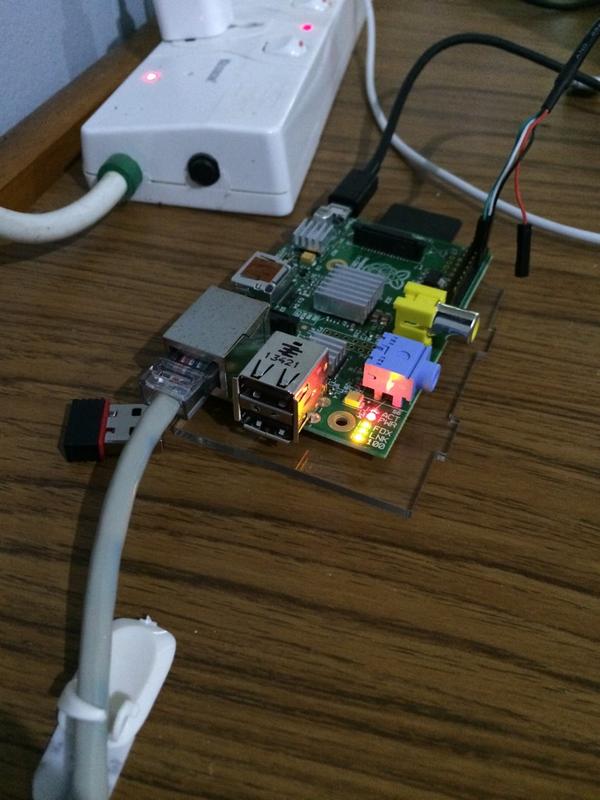I’ve always wanted my own Home Entertainment solution before I bought my Cubieboard. Now, after buying a Raspberry Pi, what I want came true. With some research and a weekend, I got it up and running perfect.
What I have in my disposal for this to happen are:
- Cubieboard A10 with Cubian - NAS, nginx, CouchPotato, Transmission, Headphones and SickBeard
- Raspberry Pi B with Raspbmc
- USB Hard Drive - Attached to the Cubieboard
- OpenWRT Wifi Router - or any router you can manipulate DNS with
- Another Wifi Router - because the main router’s coverage is spotty upstairs, Raspberry Pi is attached to this router
- TV with HDMI (obviously) - spare HDMI input for the Raspberry Pi
Cubieboard and Raspberry Pi are connected using LAN cables. I’m not too sure about the Wifi’s signal strength.
Installation & Configuration
Using the links I provided above, we can deep dive into installing each service into each components. I’m sharing the recipe to make all of them work well together.
Cubieboard
- Consider using an externally powered USB hard drive. Cubieboard (and Raspberry Pi) are sensitive to power consumption should it go beyond 2 Amps.
- I would recommend a 2 A power supply but 1 A will do.
- I installed Cubian to the NAND partition. I don’t have a spare microSD card available.
- When all of the services are started, the 1 GB memory will run out quickly leaving only a few megabytes free. Make a swap file, like here. Instead of creating at the external drive, I created the swap at the root of the NAND partition.
Raspberry Pi
- Consider using heatsinks to prevent overheating the chips if the device is to be ran 24/7.
- MUST USE at least a 1 Amp power supply.
Raspbmc
- After booting the first time, make sure it’s set a static IP Address by using Raspbmc Config Program available conveniently at XBMC’s Programs.
- I don’t have a physical remote (and keyboard) to control XBMC. I did plug a mouse to it but that’s just about it. I’m using the Official XBMC app on my iPhone and XBMC Constellation on my iPad to control XBMC.
Cubian
- Mount the external USB Hard Drive and Swapfile at boot time. Add entries to
/etc/fstab. - Give it a static IP, modify
/etc/network/interfaces. - I encourage NOT to use
FAT32partitions. It keeps unmounting. I would suggest to useEXT4for all partitions.
Samba
Since we are using Samba to share the Hard Drive, it won’t matter which filesystem is used for the USB External Hard Drive partitions. Might as well be native to Linux and release yourself of funky implementations.
In my case, I have 2 partitions mounted at /media/EVO and /media/Linx. Your mileage may vary. Here is my smb.conf as a template.
| |
I set all of my shares to be available publicly, browsable and a guest user is enough.
Transmission
Who doesn’t love Transmission? I would say subjectively, this is the best Torrent client I’ve used so far.
Some will argue that Deluge is a more suiting and Pythonic choice. I didn’t care. My simple reason will be because my wife is already familiar with Transmission.
CouchPotato
I am relieved that such application exists. I would just put in any movie I’d want to download and CouchPotato will rigirously scour the internet. It can even determine if the found item is suited to my liking or not. It’s very convenient to say the least.
Whenever a match is found, it will make an API call to the Transmission daemon to download it if it’s a torrent.
More Win: It has integration with Pushbullet. For any event, it will push something to my iPhone or my Chrome for notifications. Sweet!
SickBeard
Same as CouchPotato, only this one is for TV Shows. Need I say more?
Headphones
Same as SickBeard, only this one is for music. Need I say more?
DNS and nginx
So I wanted all the above services with a choosen subdomain that does not exists on the Internet. I only want it to exist locally. Praise The Lord for OpenWRT and nginx.
The subdomains were:
- movie.bango29.lan - CouchPotato
- music.bango29.lan - Headphones
- serial.bango29.lan - SickBeard
- torrent.bango29.lan - Transmission Web GUI
- tv.bango29.lan - Raspbmc
Here is where the DNS magic happened on OpenWRT.

nginx is used to reverse proxy the subdomains above to specific local ports where the services are serving. A simple nginx config file can be like below.
| |
So the above is the current setup for my Integrated Home Entertainment system. My next venture will be buying an HDMI audio multiplexer. Right now my 5.1 speaker system is only outputting in stereo. It’d be complete when it outputs in truly 5.1.
Signing off with a picture of my Raspberry Pi after unboxing. USB TTL cable is a must have really. Makes everything a whole lot easier.
Cheers!
